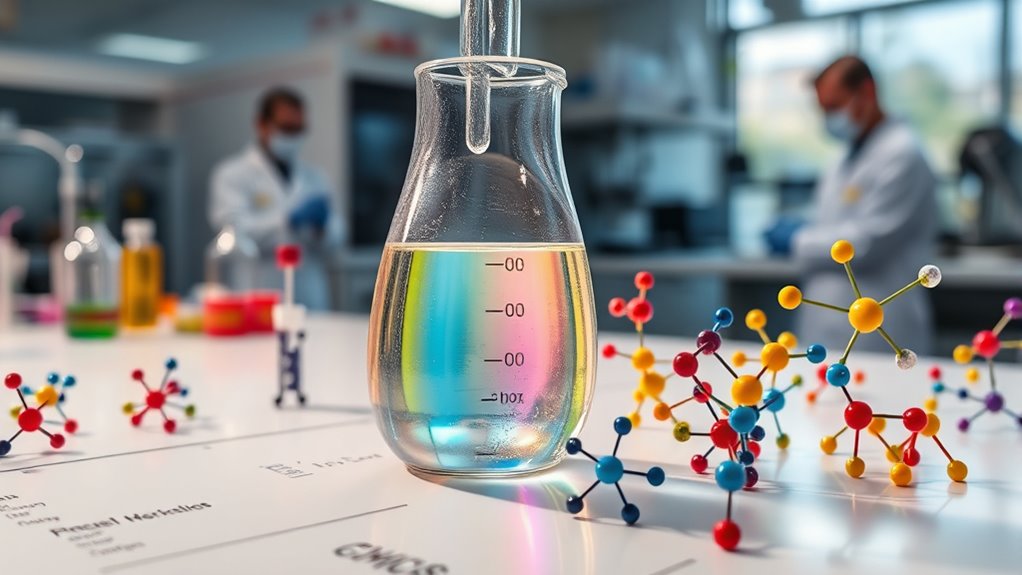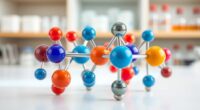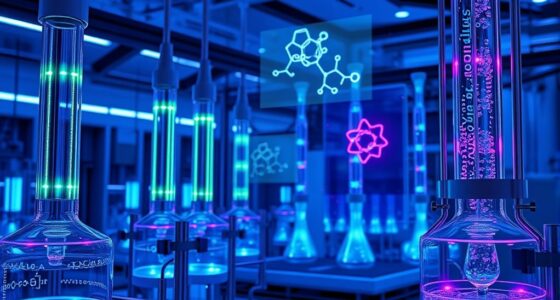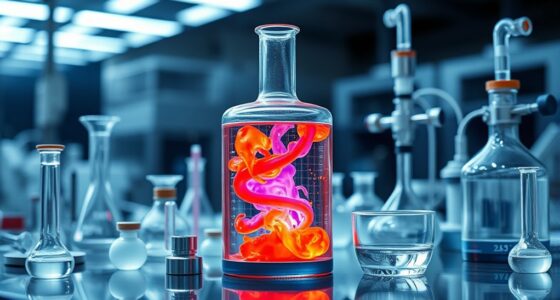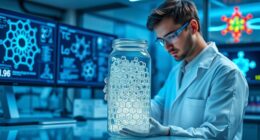Recent discoveries in organic chemistry highlight greener cross-coupling methods using earth-abundant metals, enzyme-driven reactions that boost sustainability and selectivity, and advanced chiral materials for electronics and drug development. Innovations include porous graphene membranes for efficient carbon capture and sustainable solvents that reduce environmental impact. Additionally, AI-powered processes improve manufacturing efficiency and eco-friendliness. If you want to explore how these breakthroughs are shaping the future of chemistry, there’s more to uncover.
Key Takeaways
- Development of earth-abundant metal catalysts, such as iron and copper, for greener cross-coupling reactions.
- Discovery of copper-dependent fungal enzymes enabling highly selective C–H halogenation.
- Creation of chiral materials from inorganic semiconductors for spintronics and advanced optoelectronics.
- Production of defect-engineered porous graphene membranes with high CO₂ separation efficiency.
- Integration of AI-driven real-time monitoring and autonomous systems to optimize chemical manufacturing processes.
Greener Cross-Coupling Techniques Transform Pharmaceutical Synthesis
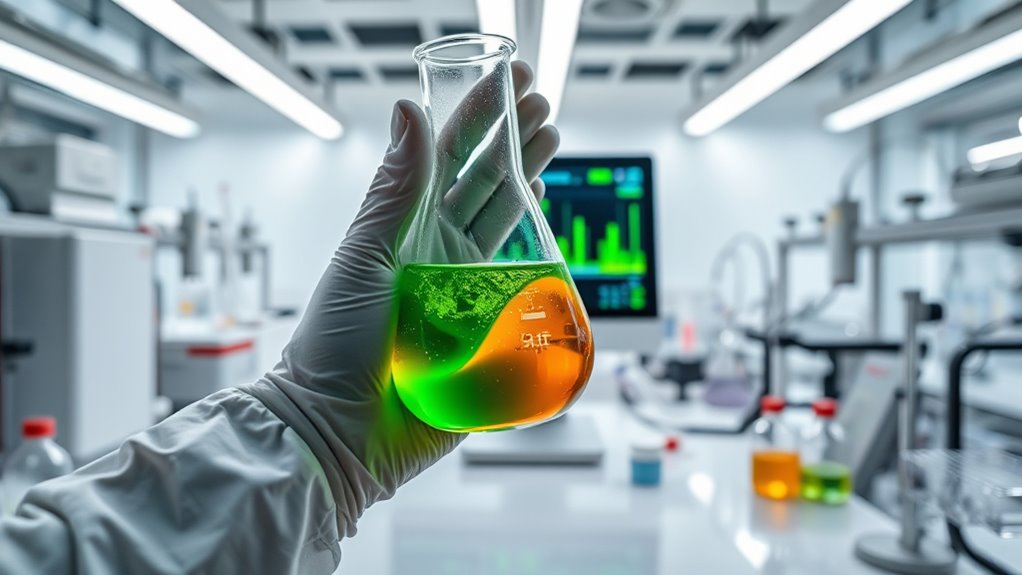
Greener cross-coupling techniques are revolutionizing pharmaceutical synthesis by making reactions more sustainable and environmentally friendly. You can now use earth-abundant metals like iron, cobalt, and copper as catalysts, reducing reliance on scarce, expensive resources. Researchers are developing sustainable ligands from renewable sources to boost catalytic activity while minimizing synthetic steps. Novel photocatalysts that operate with lower energy wavelengths further decrease environmental impact. Catalyst recyclability is a priority, helping to cut down waste and improve efficiency. Additionally, these methods tolerate complex heterocyclic structures, expanding chemical space access. In flow chemistry, continuous processes with higher yields and minimal solvent use streamline production. Recent advances in green catalysis have introduced new environmentally benign reagents, which further support sustainable practices in pharmaceutical manufacturing. Integrating these innovations guarantees greener, more sustainable pharmaceutical manufacturing without compromising performance.
Enzyme-Driven Methods Enhancing Selectivity and Sustainability in Organic Reactions
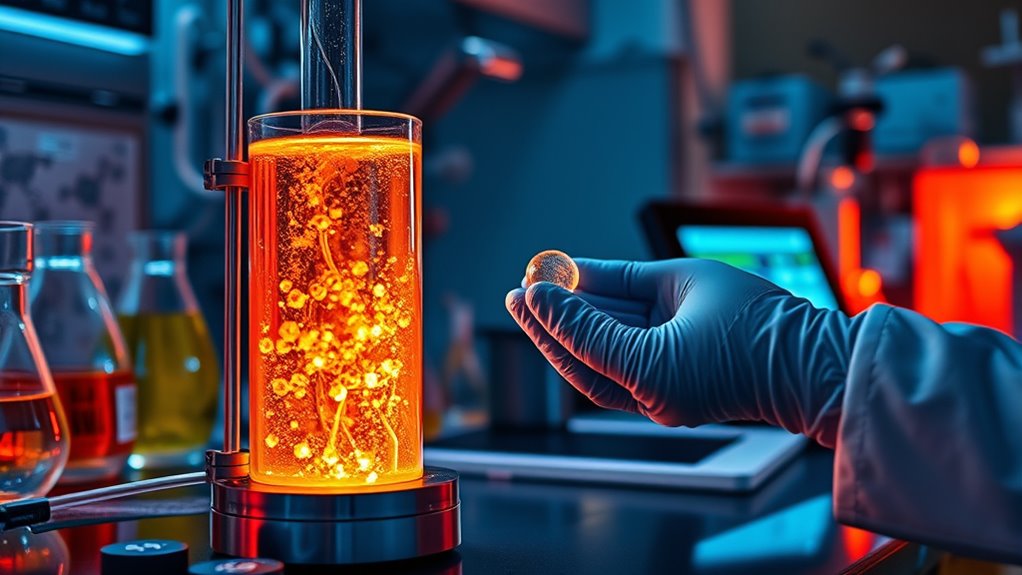
Enzyme-driven methods are transforming organic synthesis by offering unparalleled selectivity and sustainability. You can now harness enzymes that catalyze oxidation, reduction, hydrolysis, and bond formation under mild conditions, reducing energy use and waste. Recent discoveries include copper-dependent fungal enzymes capable of highly selective C–H halogenation, a breakthrough for functionalizing challenging molecules. These enzymes incorporate metals like copper, confirmed through advanced spectroscopy, to create new synthetic handles important for drug development. Enzymes accelerate reactions up to trillion-trillion-fold, providing chemical precision through electrostatic stabilization and conformational changes. They operate at ambient conditions, minimizing hazardous byproducts and enabling scalable, biodegradable processes aligned with green chemistry principles. Enzymes have been engineered to expand substrate scope and improve stability, which considerably improve pharmaceutical manufacturing, enabling efficient, cost-effective, and environmentally friendly production of complex, bioactive compounds.
Advances in Chiral Materials for Electronics and Drug Development
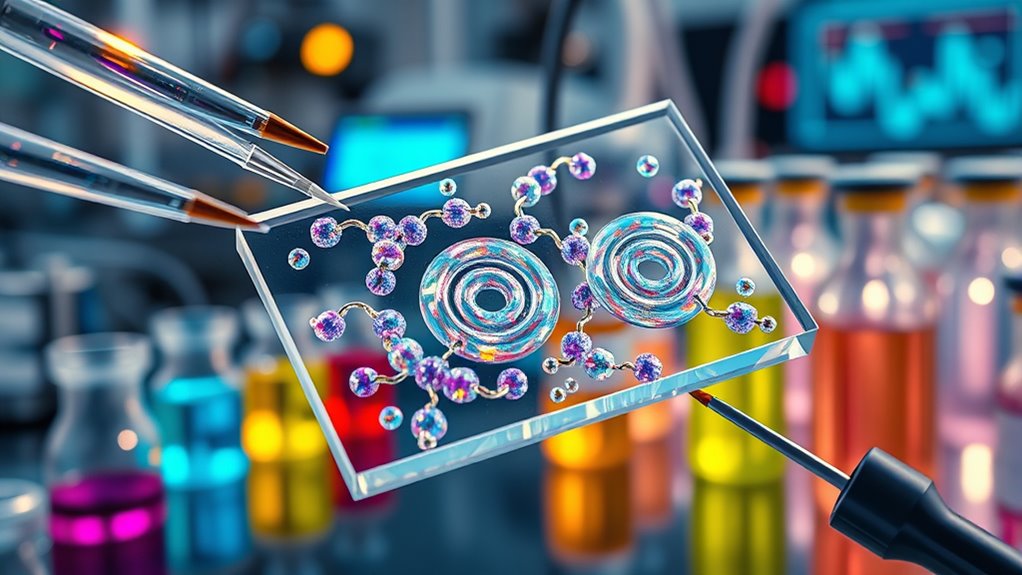
Recent advances in chiral materials are transforming the fields of electronics and drug development by enabling precise control over molecular structures and electronic properties. New synthesis techniques now allow you to create chiral materials from inorganic semiconductors, making production more scalable and versatile. The Chiral Induced Spin Selectivity (CISS) effect links structural chirality to spin-selective electronic transport, essential for spintronics and quantum computing. You can manipulate nanostructures to form chiral films from achiral semiconductors, opening doors for wearable sensors and ultralow-power devices. In drug development, chiral molecules improve drug efficacy and safety by ensuring correct stereochemistry. Recent research has also demonstrated that chiral nanostructures can be used to enhance optical properties in photonic devices, integrating chiral nanomaterials into medical diagnostics and holographic displays enhances device performance. These innovations accelerate the development of advanced electronics and safer, more effective pharmaceuticals.
Innovative Carbon Capture Solutions Using Porous Graphene Membranes
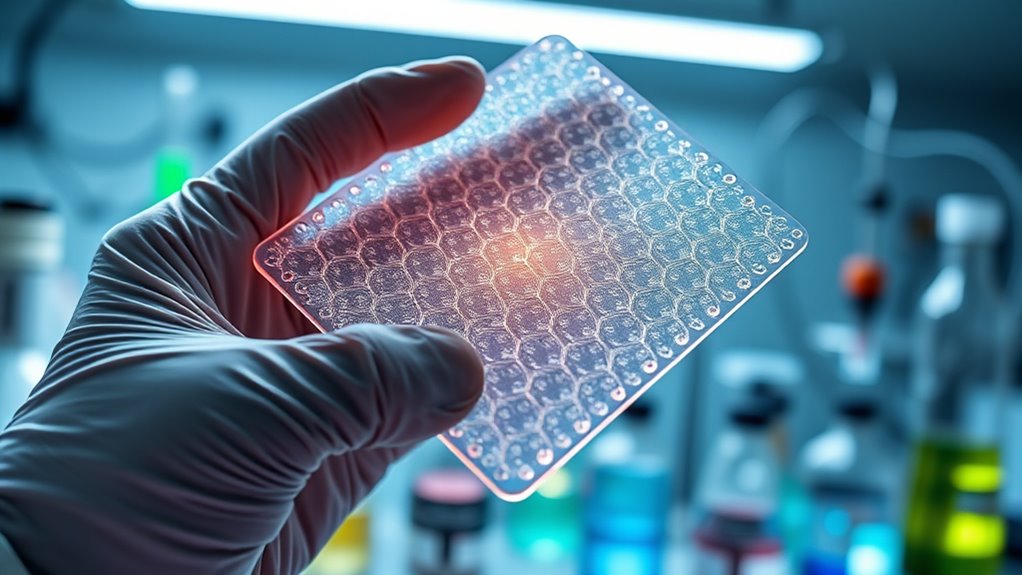
Advances in nanomaterials and fabrication techniques are opening new frontiers in environmental technology, particularly in carbon capture. You can now produce porous graphene membranes at scale by growing high-quality graphene on low-cost copper foils using chemical vapor deposition. Precise defect engineering creates nanoscale pores tailored to CO₂ molecules, while ozone etching ensures uniformity across large areas. This method yields stable, single-layer membranes up to 50 cm², overcoming previous size limitations. These membranes exhibit exceptional CO₂ selectivity, allowing efficient separation from nitrogen and methane, with separation factors above 1000. Their high permeance enables faster processing, and innovative transfer techniques minimize failure risks. Operating via pressure-driven filtration without heat input, they markedly reduce energy consumption, making carbon capture more cost-effective and environmentally sustainable. This scalable manufacturing approach also facilitates potential commercial deployment of graphene-based gas separation technologies.
Trends in Green Chemistry: Sustainable Solvents and Waste Reduction Strategies
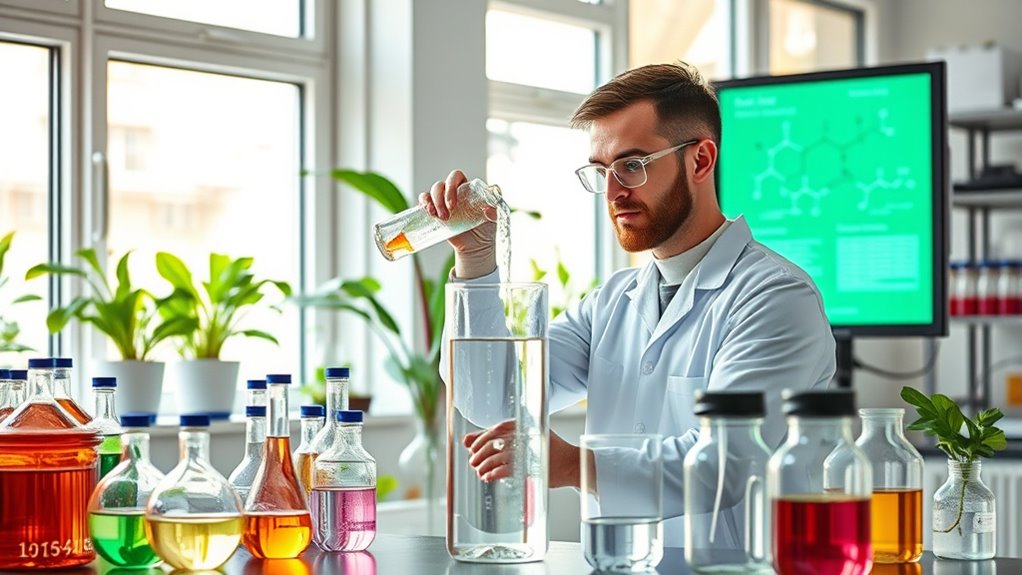
As industries seek to reduce environmental impact, the adoption of sustainable solvents and waste reduction strategies has become increasingly essential. You’ll find that ionic and deep eutectic solvents are highly tunable, enabling specific applications like CO₂ conversion and material synthesis. Bio-based solvents derived from renewable materials support a circular economy and cut pollution, while non-volatile, biodegradable options minimize resource use. These green solvents are already transforming industries such as pharmaceuticals, agrochemicals, and materials science by replacing toxic traditional solvents. Regulatory pressures and the push for renewable feedstocks are accelerating adoption, with ongoing research improving cost-effectiveness and scalability. Combining green solvents with catalysis and waste minimization amplifies sustainability efforts, aligning industries with green chemistry principles and fostering innovation in waste reduction and resource efficiency. Sustainable solvent development continues to advance through interdisciplinary research, promising even broader applications and improved environmental performance.
Improving Industrial Efficiency With Mild Catalysis and Enzymatic Cascades
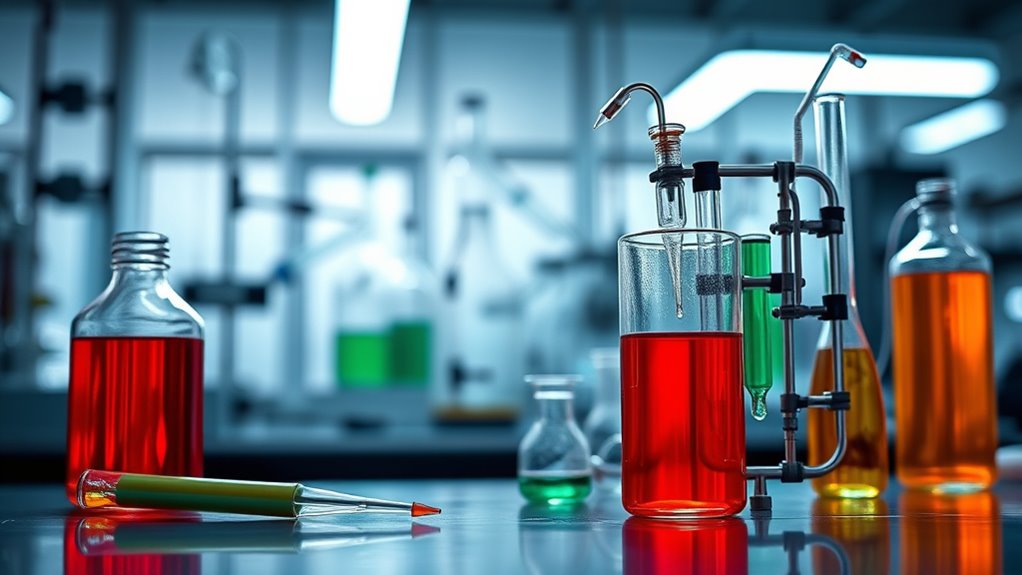
Implementing mild catalysis and enzymatic cascades can substantially enhance industrial efficiency by operating under gentle conditions that save energy and reduce waste. Enzymes work at ambient temperatures and pressures, lowering energy demands and minimizing unwanted byproducts, which is especially beneficial in pharmaceutical synthesis. They also tolerate greener solvents, aligning with eco-friendly goals. Using enzyme cascades allows multiple reactions to occur sequentially without isolating intermediates, boosting overall efficiency and yield. Engineered co-localization and cofactor recycling further optimize pathways, reducing costs. Additionally, nanocatalytic hybrid materials improve enzyme stability and facilitate recovery, supporting continuous processes. Catalysts are essential to improve reaction rates and selectivity in these processes. Across industries, these approaches have led to high selectivity in pharmaceuticals, significant waste reduction in biofuel production, and energy-efficient synthesis of specialty chemicals, demonstrating their transformative potential for greener, more efficient manufacturing.
Integration of AI and Real-Time Monitoring for Eco-Friendly Chemical Manufacturing
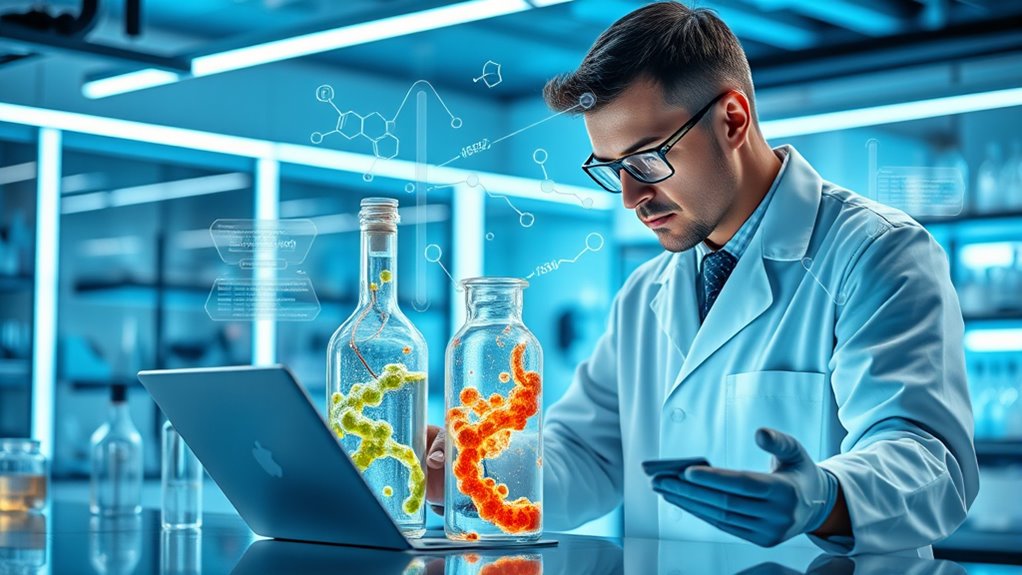
Integrating AI and real-time monitoring transforms chemical manufacturing by enabling precise control and optimization of processes. You can use AI robotic chemists to autonomously design and refine reaction conditions through high-throughput experiments and dynamic recipe adjustments. Closed-loop systems leverage AI models to iteratively improve synthesis pathways without human intervention, while real-time data analysis helps you adjust parameters instantly to maximize yield and reduce waste. IoT sensors track temperature, pressure, and pH with millisecond accuracy, and cloud platforms process this data for tight process control. AI-powered fault detection and impurity tracking alert you to deviations or byproduct formation early, preventing quality issues. Overall, this integration leads to greener, more efficient processes, cutting energy use, waste, and emissions while accelerating scale-up and ensuring regulatory compliance.
Frequently Asked Questions
How Do Enzymatic Methods Compare Cost-Wise to Traditional Chemical Processes?
You might notice that enzymatic methods often cost less in reagents but have higher expenses for enzymes and equipment. While chemical processes are faster and more scalable, they generate more hazardous waste and require more energy. Enzymatic synthesis produces fewer waste products, making it environmentally friendly and potentially cheaper overall. Balancing speed, scale, and waste management, enzymatic methods can be a cost-effective choice for specific applications.
What Are the Limitations of Current Green Solvents in Industrial Applications?
You’re wondering about the hurdles green solvents face in industry. You’ll find that scalability stumbles due to cost concerns and supply chain struggles. Stability suffers under stress, and solvent versatility limits applications. You’ll also see regulatory reluctance and market resistance, making widespread adoption challenging. Despite their eco-friendly appeal, these limitations slow green solvents’ progress, demanding further research, regulation, and real-world readiness before they can truly replace traditional options.
How Scalable Are the Latest Carbon Capture Membrane Technologies?
You’ll find that the latest carbon capture membrane technologies are quite scalable. Researchers have developed methods to produce large graphene membranes up to 50 cm² efficiently and cost-effectively. These advancements mean industrial-scale production is now feasible, with energy-efficient processes and improved material quality. As a result, you can expect broader application in industries, making carbon capture more practical, affordable, and ready for integration into existing infrastructure.
What Challenges Exist in Synthesizing Highly Pure Chiral Compounds?
You face several challenges when synthesizing highly pure chiral compounds. Achieving enantiomeric purity is tough because designing enantiomerically pure monomers requires precise compatibility and control. High-temperature synthesis risks racemization, while limited chiral sources restrict diversity. Maintaining stereochemical integrity during functionalization is complex, and scaling up reactions often compromises purity. Overcoming these hurdles demands innovative methods, better catalysts, and standardized protocols to guarantee consistent, high-quality chiral products.
How Does AI Optimize Eco-Friendly Reaction Conditions Effectively?
You’re curious about how AI enhances eco-friendly reaction conditions. Did you know AI-driven methods can reduce waste by up to 30%? By analyzing vast datasets, AI predicts ideal reaction parameters, selects greener solvents, and designs catalysts that minimize byproducts. It continuously learns from experimental results, fine-tuning conditions for sustainability. This active approach ensures reactions are not only efficient but also environmentally responsible, aligning with green chemistry principles.
Conclusion
You might think that sustainable chemistry is just a trend, but recent discoveries prove it’s essential for our future. Greener cross-coupling, enzyme-driven methods, and AI integration aren’t just innovations—they’re transforming how you can make pharmaceuticals and materials more eco-friendly. If you believe in scientific progress, these breakthroughs suggest that sustainability and efficiency go hand in hand. Trust me, embracing these advances could redefine what’s possible in organic chemistry tomorrow.
